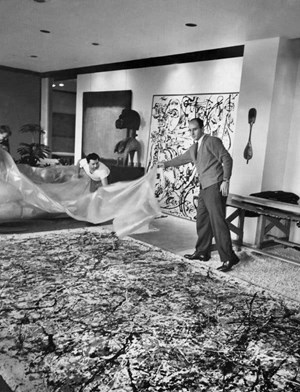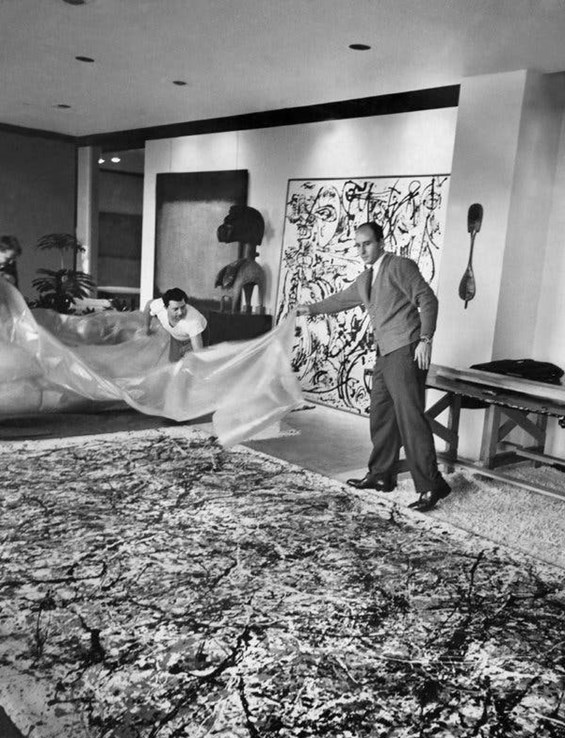
Ben Heller, an influential New York art collector and dealer best known for his early embrace of Abstract Expressionism and the sale of one of its masterworks to an Australian museum, which caused an international furor, died at 93, New York Times reports.
Image: The art collector and dealer Ben Heller at his Manhattan home in 1959 helping moving men remove a covering from Jackson Pollock’s “One: Number 31, 1950.” Pollock’s “Echo” is against the wall. The painter Mark Rothko called Mr. Heller’s Central Park West apartment “the Frick of the West Side.”CreditCreditThe Pollock-Krasner Foundation/Artists Rights Society (ARS), New York; Eddie Hausner/The New York Times
Ben Heller, an influential New York art collector and dealer best known for his early embrace of Abstract Expressionism and the sale of one of its masterworks to an Australian museum, which caused an international furor at 93.
The cause was a stroke, his son-in-law Peter Adler said.
Mr. Heller’s sale of Jackson Pollocks's "Blue Poles" to the National Gallery of Australia, then under construction in Canberra, the nation’s capital, was announced in September 1973. The news caused an uproar in the New York art world; in Australia it nearly brought down the Labor government of Prime Minister Gough Whitlam, who had to sign off on the $2 million sale.

The art collector and dealer Ben Heller at his Manhattan home in 1959 helping moving men remove a covering from Jackson Pollock’s “One: Number 31, 1950.” Pollock’s “Echo” is against the wall. The painter Mark Rothko called Mr. Heller’s Central Park West apartment “the Frick of the West Side.”CreditCreditThe Pollock-Krasner Foundation/Artists Rights Society (ARS), New York; Eddie Hausner/The New York Times
In New York, Mr. Heller was criticized for letting the painting leave the country, and for blurring the lines between collector and dealer. Most startling of all was the astronomically high “Rembrandt class” price, so called because the amount paid was more typical of old master paintings. It was the largest sum offered for an American painting — a record that held for 10 years — and it made the investment potential of modern and contemporary art starkly clear.
Mr. Heller said he wanted the painting to leave the country so that it could be seen by an international audience and have a larger impact. It very much did.
In Australia, the purchase was controversial because “Blue Poles” was American rather than Australian, abstract rather than figurative and very, very expensive. But, with time, it would be embraced as a national treasure and a turning point in the country’s coming-of-age as a nation separate from Britain. Today it is a regular stop for Australian schoolchildren.
James Mollison, the young director of the National Gallery and the initiator of the purchase, went on to build one of the best collections of Abstract Expressionist paintings outside the United States.
In an email, Ann Temkin, chief curator of the Museum of Modern Art’s department of painting and sculpture, called Mr. Heller “an essential figure in the history of Abstract Expressionism” and said he had “fearlessly championed the art he loved even as others found it incomprehensible.”
Andrew Fabricant, the chief operating officer of the Gagosian galleries, said in a telephone interview: “You’re not going to see anyone like him again. He recognized something colossal in American culture. He started the whole thing.”

ArtDependence Magazine is an international magazine covering all spheres of contemporary art, as well as modern and classical art.
ArtDependence features the latest art news, highlighting interviews with today’s most influential artists, galleries, curators, collectors, fair directors and individuals at the axis of the arts.
The magazine also covers series of articles and reviews on critical art events, new publications and other foremost happenings in the art world.
If you would like to submit events or editorial content to ArtDependence Magazine, please feel free to reach the magazine via the contact page.